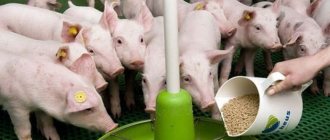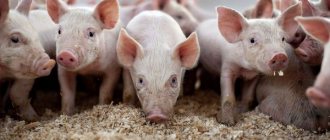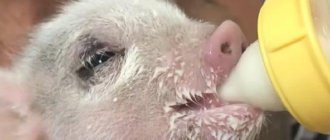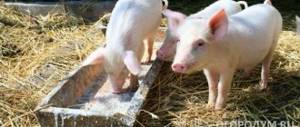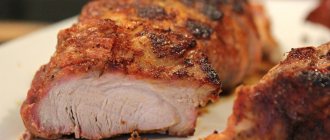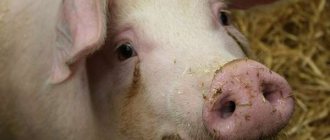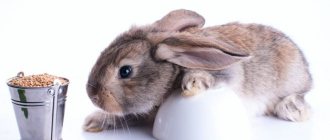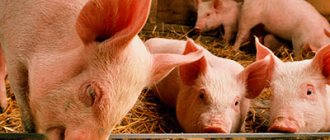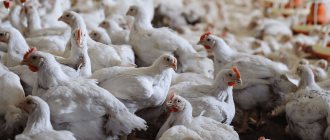Is it possible to feed pigs corn?
Raising piglets is definitely a lucrative business.
In a short time you can get an animal with good weight, the right amount of fat and meat, but for this it is important to use only high-quality feed. Most often, farmers feed pigs in the form of table scraps mixed with commercial feed. Less often, they share this food using either one or the second option. But in any case, pigs definitely need a varied diet, on which successful weight gain depends. It is known that pigs happily consume various cereals, which raises the question: can be given corn or not?
Is it possible to feed pigs corn?
Feeding pigs corn is the basis for successful animal weight gain. It can be used both for sows and for piglets or fattening pigs. It is this grain that contains the most energy and nutrients, so feeding pigs corn not only possible , but also necessary.
Let's consider the benefits of different types of this product for animals:
Corn grain (g)
Corn food, although it contains little protein, supplies the body with energy, and therefore promotes weight gain.
Diet and feeding standards
In general, corn should make up half of the total feed, otherwise the animal will not have enough protein, which will negatively affect its health. Let's look at how to feed corn as pig feed .
- It is important to grind before giving these cereals. It is better to grind immediately before feeding, otherwise the fat that is in the corn will begin to oxidize and give off bitterness, and the animals will not eat it.
- This cereal should be ensiled in the milky-waxy stage of maturity.
- Corn for small piglets is useful during the growth period - then the amount of this feed can reach 50% of the total diet. If the piglets have just been born, then the amount of corn in the menu should not exceed 5%.
- A couple of months before slaughter, grains are reduced in the diet, otherwise the lard will turn out soft and spreadable.
In general, food for snouts can be collected from barley (40%), wheat (30%), peas (10%), corn (10%) and oats (10%).
Can pigs eat corn on the cob ? Some farmers, knowing that pigs get fat from the abundance of corn in their diet, still continue to give this food to the animals, since there is a certain demand for such meat and lard. As a rule, the diet consists not only of corn, but also wheat, zucchini and water. But you can also give cereal feed on the cob, the main thing is no more than a bucket a day. An equally important issue is the quality of corn, because pigs should be given only cereals of a certain type.
How to distinguish feed corn from food corn?
When choosing what is best to feed pigs for rapid growth , many farmers choose corn. But there are several types of this cereal, and for snouts it is better to use feed corn. How can it be distinguished from the food that a person eats?
- By appearance. The food variety has short, thick ears of a light beige color, while the fodder variety is brighter and longer.
- Feed grains are harder than food grains.
- Taste – food sweeter. By and large, you can try this cereal right at the time of purchase - it will not cause harm to your health.
How to feed piglets at home video
See how to properly make mixtures for feeding pigs at home
Types of feed
Since pigs have a single-chamber stomach, it is easier for them to digest concentrated feed, and feed rich in fiber is digested more slowly. The degree of deliciousness of the meat product entirely depends on the quality of the feed.
Hence the division of all feeds into 3 conditional groups:
- These feeds are recommended if you plan to raise an animal to produce high-quality meat products: pea kernels, millet, barley, rye, carrots, beets, zucchini, potatoes, grass, legume flour, meat production waste. This nutrition makes fattening pigs effective, since all feeds in this group promote rapid growth, the meat is tastier, and the lard is denser and grainier.
- These are less suitable and healthy foods: bran from rye and wheat, corn, buckwheat. Their permissible content in the pig diet is no more than half of the total feed mass.
- These feeds have a negative impact on the final result: oats, soybeans, cake.
Important! To avoid their harmful effects, after the pig reaches a weight of 60 kg, they are categorically excluded from the feed.
The diet of animals is adjusted 2 months before slaughter. Products of the 3rd group are replaced with foods of the 1st group.
Combined feeds are offered to pigs in slightly moistened or dry form. Before use, root vegetables and vegetables are washed and steamed, and the greens are thoroughly chopped after washing.
There are 3 types of nutrition for piglets:
- wet (traditional at home);
- liquid;
- dry.
Wet
Economical option. On a large farm, it is very labor-intensive and suitable for household use. This diet consists of porridge and a mixture of greens, boiled potatoes and vegetables.
It is advisable to use human food waste, corn, fish oil, barley cake, wheat, bran. Dishes are prepared in advance.
It is necessary to promptly remove spoiled or uneaten food from the feeder.
The advantage of this type of food is that such food is more natural for animal nutrition and almost all the ingredients can be grown in your own household, which significantly saves money, but the disadvantage is that the labor-intensive process of preparing porridges and mashes is not suitable for a large number of livestock.
Liquid
The type of feeding is based on direct manual preparation of feed. When feeding with liquid, liquid kitchen waste (without chemicals) and curdled milk are used in the feed mixture.
The liquid type of feeding is beneficial for pig farmers who have greens and succulent feed on their farm, as well as sufficient liquid food waste.
Dry
The option is unique and suitable for individuals at any period of their life.
The dry type involves the use of ready-made experimentally obtained feeds that are enriched with essential microelements and vitamins.
Feeding animals this way saves time: you just need to ensure the presence of enriching mixtures of biologically active substances (premixes) in the feeder, and clean water in the drinking bowl.
Important! If pigs are fed dry food, they must have constant access to fresh water.
For households, the method is also less troublesome and time-consuming: you need to grind the grains in advance, mix them with other ingredients, add premixes and distribute the norms to the animals in feeders.
Each grain crop has its own nutritional value, so you need to include 2-3 varieties of grains in your ration, which will help make the food more balanced.
Pros:
- manure from animals fed a dry diet does not have a strong odor and is suitable for use in the garden after 12 months;
- pigs fed this type of food grow actively and gain weight well;
- protects animals from problems with the digestive system;
- no spoilage or souring of leftover feed in feeders;
- This food provides balanced nutrition.
Corn for pigs
The main goal of pig farming, like any other branch of agriculture, is to make a profit. The high share of feed in the cost of pork makes it necessary to look for ways to reduce their cost. One of the ways to reduce feed costs is to produce and prepare your own feed using efficient technologies.
Harvesting wet crushed corn grain in the regions where it grows and feeding the crushed corn to pigs can improve the economics of the enterprise.
Experts say
Many pig farmers still firmly believe that grain for pigs must be crushed. A test carried out in Denmark has shown conclusively that the particle sizes produced by crushing wet corn in disc and roller mills are perfectly suited to the needs of pigs.
Danish experts led by Helge Larsen conducted two tests using a sieve method. In the first case, fractions of corn crushed on a Murska 2000S2x2 roller mill with a moisture content of 37.9% were studied, in the second case, fractions of corn crushed on a Murska W-Max20C disk mill with a moisture content of 41.1% were studied. Both tests were carried out after flattening in mills with a capacity of 35-45 t/h.
As can be seen from the table, the result of the flattening quality was very good, even better than what could be expected. The proportion of particles less than 1 mm in size in the first experiment was 51.4%, and in the second – 72.4%. In this way, the pig can get between half and two-thirds of the kernels of finely ground corn. On the other hand, pigs also need fiber, which is the coarser grain particles. When coarse particles are present in sufficient quantities in the feed mass, this contributes to better permeability and digestibility of food.
For all ages
The high yield of wet corn, combined with high energy value, makes the “queen of the fields” an indispensable component of the diet of pigs at almost all stages of cultivation. Traditional grinding of grains in crushers, almost to flour dust, leads to problems with the health of animals, including their death. When feeding flattened milk, the mortality rate decreases. The blood sugar level of pigs stabilizes, which affects their general well-being, and less and less medications are required for treatment.
If previously flattened canned corn grain was fed only to fattening pigs, now it is given even to sows, although in limited quantities, especially during pregnancy. But for suckling sows, the energy of corn is irreplaceable. When eating canned corn, sows produce more milk to feed their piglets. As a result, the weight gain of suckling piglets increases and they become calmer. The experience of one of the largest pig farms in Denmark shows that after introducing crushed corn grain into the sow’s diet in the amount of 30% of the feed weight, the piglets at the time of weaning began to weigh 1 kilogram more than with the previous feeding ration.
Use of wet corn grain in pig feeding in France
Corn, stored wet, is an important part of the pig diet on many farms. Typically, after harvest, corn is dried and stored in a ventilated bin with a humidity level of approximately 15%. Meanwhile, for many years in a row, French livestock breeders have been practicing storing grain corn in wet form, that is, without a drying step, and today this method is becoming increasingly popular. (At the end of the article there is a table for calculating the diet for pigs, note from the BOSS-Agro magazine).
French context: Feed costs represent 62% of total pork production costs. To feed sows and piglets, producers still mainly purchase complete factory-made feed. Today they make up two thirds of the total food consumed by pigs, while the remaining third comes from feed prepared by farmers themselves on their farms. There are more and more such farmers in recent years, thanks to the increasing use of wet corn grain. In the Brittany region, nine out of ten farms that produce their own feed use wet corn grain. They either produce complete feed based on wet corn with the addition of other raw materials, or simply harvest corn and supplement it with factory feed. In the first case, obviously, a factory for the production of compound feed must be installed on the farm.
There is a clear increase in the areas devoted to wet grain storage of corn.
In France, more and more areas are devoted to the storage of wet corn. In 2021, they amounted to 180,000 hectares, of which 100,000 were intended for the production of pig feed. In addition, wet corn grain is increasingly used to feed beef and dairy cows, as well as fatten poultry and small livestock.
In practice, two main preservation methods are used: ensiling of crushed wet corn grains and inerting whole grains. Both methods involve harvesting at a relatively wet grain stage (32-40% for silage and 26-35 for inerting). In both cases, the harvested corn must be stored in an airtight environment, especially in the case of inerting.
Preservation of wet corn grain pursues the following objectives: - the most efficient use of cereals produced by the farm; — increasing the food autonomy of farms; - reduction or at least optimization of food costs, especially during periods of sharp price fluctuations.
Canning wet corn grains: the undeniable advantages of this technique from economic, technological, food and environmental points of view
The success of wet corn storage technology has been driven by the dramatic increase in energy costs, which has forced producers to find ways to reduce drying and transportation costs while still maintaining the high nutritional value of grain corn as a high-calorie livestock feed. Over the past fifteen years, the cost of the drying stage has been steadily increasing (on average +5% per year), and today these costs form a significant part of the selling price for corn. Comparison of the cost of feed for meat-grade pigs based on wet corn grains and based on dry cereals for the period 2010-2012. showed a benefit of 27 €/t in favor of wet grain storage.
Preserving wet corn kernels involves harvesting early enough when weather conditions are more favorable, the soils are well-bearing, the plants are fairly erect and their health properties are well protected. Livestock farmers get more accurate information about the quality of corn when it is produced on the same farms or purchased from neighboring farms, compared to purchasing from a harvester. Wet grain canning is a natural and easy-to-implement way to store corn, and today there are storage facilities available for any type and size of farm.
The nutritional benefits of wet corn harvesting are also numerous. It is a tasty feed with nutritional values similar to dry corn when inerted and higher when ensiled. Wet grain contains more easily digestible phosphorus, and for pig farmers such feed is especially interesting, since the quality of the fats present in it contributes to optimal meat processing in salting shops. Finally, eliminating the drying step from the production cycle significantly reduces greenhouse gas emissions into the environment.
What is the nutritional value of wet corn feed for pigs? Very high, especially when silaging!
Studies from the 1980s to the present have found similar animal growth rates and feed nutritional efficiency measured in piglets and beef hogs fed the same dry corn, wet silage corn, or wet inerted corn. As a result, producers believed that 1 kg of dry matter of dry or wet corn contained the same nutrients. However, later, many livestock breeders, livestock specialists and even feed manufacturers noted higher performance indicators of wet grain feed in the first months of preservation and more variable performance in warmer months, and at their requests a special study of feed digestibility was carried out (ARVALISFNPSMS-UFS 2009-2012- 2013).
The first study, published in 2009, showed improved fecal digestibility of key nutrients (energy, protein, starch, fat) when fed with wet corn silage—a finding that was equally positive across all three corn varieties compared in the study. According to this first test, digestible energy values in batches of wet corn silage increased by 3.7%.
The second study was published in 2012 and compared identical batches of dry corn, wet corn silage, and wet corn stored in an inert environment. Both fecal and enteric energy digestibility from wet kernel corn silage were higher than inerted wet corn and dry grain corn: +4% for wet kernel corn silage; +1.4% for wet corn grain in an inert environment (the difference in performance with dry grain corn is insignificant).
In 2014, a third study was published. Its purpose was to compare two forms of wet corn relative to the same corn dried immediately after harvest, at three time points (15, 90 and 180 days after harvest). The results of the study again revealed that wet corn silage was better digestible by pigs than inerted wet corn or dry corn, and the length of grain storage did not affect the nutritional value of wet forms of corn. In addition, the nutritional value, and in particular the energy value, of wet corn silage is higher compared to dry corn and wet inerted corn. However, when dealing with wet forms of corn kernels, proper storage and regular and frequent monitoring of kernel moisture levels as the silage is used is critical to calculating variations in the nutritional value of corn. If an error is made in estimating grain moisture content, it will result in variations in dietary energy calculations that will be greater than the normal variations recorded in the study.
More easily digestible phosphorus and improved adipose tissue composition in pigs.
The total phosphorus content in corn is approximately 3 g/kg DM, but the pigs’ body absorbs only a small part of it (28%), therefore, the remaining two-thirds end up in manure. Even if this figure needs clarification, the level of phosphorus digestibility from wet grain, corn will be higher, accordingly, less phosphorus will end up in manure, and the pigs’ need for mineral phosphorus will also decrease or be reduced to zero (we are talking about an 80-kg ready-made pig to slaughter).
Corn is rich in polyunsaturated fatty acids, in particular linoleic acid (C18:2), and if the amount of this acid in food is too high, the quality of the animal’s fat tissue decreases, making its meat more difficult to process into a dry product in a salting shop. Research and surveys have shown that if pigs' diet consists of 72% wet corn, then their adipose tissue will be better adapted to the quality requirements of processing meat into dry sausage products.
Corn grain: at the same time the most calorie-rich and least protein-rich cereal.
The energy value of corn grown in different regions of France remains stable and uniform. For pigs, the energy value of corn is 12.8 MJ/kg dry matter and 13.2 MJ/kg for sows. This calorie content is associated with a high content of starch (760 g/kg dry matter in 2013) and fat (40 g/kg dry matter). However, corn contains little protein (82 g/kg DM), so corn-based diets need to be supplemented with appropriate supplements. This is usually soybean or rapeseed meal.
How to calculate the optimal diet for pigs?
The following factors are taken into account when calculating:
• recommendations, the purpose of which is to reduce animal feed rejection while maintaining the high quality characteristics of raw materials obtained from animals (CORPEN). According to these recommendations, in order to optimally match the nutritional value of the feed to the needs of the animals, a separate diet is developed for each type of pig: for meat pigs (25-60 kg live weight), the emphasis is on rapid growth and high-quality final fattening (reaching a weight of 60 kg before slaughter) , feed for sows takes into account the stage of production of young animals (gestation or lactation), etc.
• balanced feed based on the ratio of nitrogen and energy. Feed for pigs must include lysine, an essential amino acid for these animals. The remaining basic amino acids (methionine, cystine, threonine, tryptophan) should be contained in minimal quantities relative to lysine to optimize performance.
Wet corn grain is widely used in pig feeding.
In the diet of meat pigs it ranges from 50 to 70%. Animals are primarily fed in the form of soup according to a progressive daily plan with an upper limit of 60 kg live weight for castrated males and 80 kg for females.
• 21 MJ/day (5000 kcal) for males • 24 MJ/day (5700 kcal) for females
Dairy piglets begin to be given wet corn quite early, and young piglets already consume it quite actively, and they are less likely to have digestive problems. In addition, a separate feed is being developed for young piglets. After weaning piglets from the sow, their diet consists of 30-50% wet corn, this makes it easier to distribute. If corn is being distributed ad libitum, transferring kernels into feeders should be avoided because feed with wet corn kernels tends to heat up. Basically, corn feed is given to pigs as is, in its pure form, but some livestock farmers prefer to feed it in the form of soup.
Sows' feed typically consists of 30-50% wet corn kernels.
While the sow bears and feeds her offspring, the task of her diet is to replenish the body’s reserves spent on lactation. From the beginning of gestation, it is necessary to adapt the sow's daily allowance so that she is in the best condition at the time of farrowing. Increasing the volume of feed in the first 30 days of gestation can increase the weight of newborn piglets. During lactation, it is important to ensure that the sow receives as much feed as possible to avoid weight loss, but care must be taken not to feed too much to avoid the risk of refusal.
Jean Georges CAZEAUX, FNPSMS
The contents of this text reflect the views of the author and the author bears full responsibility for them. The European Commission disclaims responsibility for the consequences of the use of the information contained in this text.
Previous article: Sunflower 2021: plans and prospects
Feed used in feeding pigs
Balanced feeding of pigs at home, with the use of high-quality feed, is an integral part in obtaining high-quality and environmentally friendly meat.
This article is additional material to the article Basic feeds used in feeding pigs
In this article we will answer the question - what kind of food is available at home.
A pig, like any animal, has a period of intensive growth. This period can last from 6.5 to 8 months, until the animal reaches a weight of 100-120 kg. It will be right to make the most of this time. However, these figures were obtained under ideal conditions in specialized farms.
The breed of piglet influences the result of fattening. Pedigree pigs have a high growth rate and are most suitable for fattening.
They can have 100-120 kg of live weight by 6.5-8 months. Pigs that are bred at home will reach this weight closer to 12 months.
Conventionally, all food can be divided into several groups
Concentrated feed
These types of feed contain large amounts of carbohydrates (22.9-69.2%), fat (2.1-11%) and protein (9.4-83.9%), and contain water in small amounts (8 -11%) and fiber (3-9%).
Grain feed should be ground before feeding to pigs. The smaller the grain grinding fraction, the better it is digested by animals.
Corn, which contains a lot of carbohydrates and fats, is optimal for feeding pigs, which cannot be said about protein. It can be present in 65% of the feed ration. Barley and oats have an excellent effect on the quality of meat. They are well digested by the pig. Peas, vetch and lentils contain a lot of protein and have a good effect on the quality of meat.
From mill waste (which is also classified as concentrated feed), I widely use bran and mill dust when feeding pigs.
Wheat bran is most suitable for feeding, because it is easily digested, but you should not abuse it. Mill dust consists of flour, dust from millstones and bran.
I widely use cake and meal from oil mill waste. This food contains up to 35% protein. When fattening, a pig is given only up to 300 g per day, and a pregnant pig is given twice as much. Only flaxseed or sunflower meal is suitable for pigs. It should be detailed in advance.
Animal feed
Feeds of animal origin include meat and bone meal (MBM) and fish feed meal, buttermilk, whole cow's milk, skimmed cow's milk (skimmed milk), whey, acidophilus (acidophilus curdled milk). They contain a lot of complete protein.
It is recommended to use meat and bone meal in the diet no more than 100-200 g per head per day. It contains up to 65.0% protein, 8.0-15.0% fat and 10.0-25.0% ash.
Fish meal is given up to 150 g per head per day. It contains from 48% to 70% protein and from 10% to 20% fat.
Cow's milk, skim milk, whey, acidophilic yogurt, buttermilk - good food that piglets eat with pleasure. These feeds are given to pigs by adding them to other feeds.
Mineral feed
Mineral feeds compensate for the lack of minerals in other feeds. These foods include: table salt, chalk, lime, bone meal and tricalcium phosphate.
What are pigs fed at different stages of their growth?
From 2 to 4 months
To provide comprehensive nutrition during this period, it is not enough to use vegetables with mixed feed. It is also required to implement:
- Oats.
- Small portions of pea or barley porridge.
- Milk and dairy products.
- Silage.
- Roots.
- Hay dust.
In addition, it would not be superfluous to add chalk and salt, the daily norm of which, for a pig at this age, is about 20 grams.
After 4 months
After 4 months, the so-called growing period begins. Here, to ensure rapid growth, concentrated feed should be used, for example:
- Flour and products made from it.
- Remains of cleaning from the kitchen.
- Meat and meat products.
- Special mixtures.
You can add bread mixed with vegetables or bran
Do not give your animal bananas or citrus fruits; their digestive system is not adapted to digesting such foods and may malfunction when consuming them. Also, do not pour coffee or tea onto the pig.
Feed pigs no more than 3-4 times a day, and also make sure there is enough fresh water. This will help avoid disorders of the animal’s digestive system.
To get a high-quality result, it is recommended to use piglets born in winter or spring
